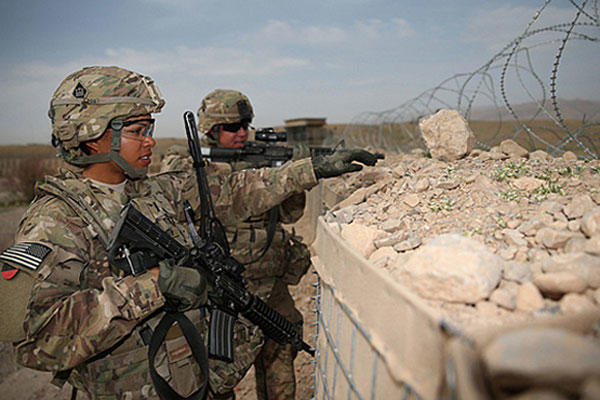The U.S. Army general in charge of training recently wrote about the service's examination of gender neutral standards to open the infantry and other combat-arms jobs to female soldiers.
The piece by Gen. Robert Cone, commander of Training and Doctrine Command, appears in the November issue of Army Magazine, the same month three female Marines made history by graduating from Marine infantry training.
Last January, former Defense Secretary Leon Panetta ordered all services to open combat-arms roles to women that so far have been reserved for men.
The services have until 2016 to make this happen, but currently the Marine Corps has outpaced the Army when it comes to exposing females to the physically demanding standards male troops must endure to serve in infantry and special operations units.
The Corps' research effort to allow females to go through enlisted and officer infantry courses is a major step toward the U.S. military formally introducing women into such male-dominated fields.
The Army has announced it is studying all aspects of the effort, but officials remain guarded about the specifics of the plan to assign females to direct-action units such as armor, Stryker and light infantry battalions.
In his article, Cone defends what has been called the Army's cautious approach.
"We must do this right, lest we put women and our institutional credibility at risk," he writes. "The combat readiness of our well-seasoned Army must remain the first priority."
In both the Marine Corps and the Army, the question seems to focus on physical standards -- will the services have to lower the physical standards required for these jobs before women can serve in combat-arms units?
Marine Corps officials maintain that women will have to meet the required, performance-based standards if they want to serve in infantry units.
Cone wrote that soldiers agree with the Corps' position, citing interviews that TraDoc has conducted with about 2,500 soldiers thus far.
"Across the force, everyone -- including our female soldiers and leaders -- insisted that we not lower the standards for service in combat MOSs," Cone wrote.
It's currently unclear what the Army is going to do as the service studies what it calls "gender-neutral" standards.
"First, we must clearly define the standards for service in MOSs currently closed to women. A recent survey of infantry recruits shows our standards are antiquated," Cone wrote. "The truth is that the shortest infantryman we recruited last year stood under 5 feet tall; the lightest weighed less than 100 pounds. We are clearly accepting people into these positions who may be physically overmatched by the demands of modern combat."
So the Army is looking at the most physically demanding tasks artillerymen, engineers, infantrymen, scouts or armored crewmen must perform in an attempt to determine how to measure a soldier's ability to perform them, according to Cone.
Branch commandants and their command sergeants major led teams that identified 31 tasks across the closed MOSs. The Army established performance standards for each task and "random populations of MOS-qualified soldiers" in combat-arms units attempted to perform the tasks, Cone said.
"By and large, we found that our proposals were accurate," Cone wrote. "Regarding a significant portion of the test population that was unable to meet the standards, we are looking to see if the cause is a training shortfall or if the proposal exceeds the actual standard needed within combat-arms units.
"For those instances in which nearly everyone passed the physical test, we are examining if our proposed standard is too low or if the task is not really a discriminator."
The Marine Corps has launched a similar effort. The Corps has been evaluating the physically demanding tasks required for combat-arms related jobs in about 335 MOSs.
The service conducted "proxy tests" this summer, involving 400 females and 400 males at Quantico Marine Base, Va., and at Camp Lejeune, N.C. The data from the performance on those proxy tests will be "correlated" against the performance of the Marines doing physical fitness and combat fitness test events, Marine officials said.
The Army's effort may include more tasks as researchers continue to speak with these types of units, Cone wrote. TraDoc is working with U.S. Army Medical Command and the U.S. Army Research Institute for Environmental Medicine to ensure the results of the effort remain scientifically valid, according to Cone.
"We will not only develop a gender-neutral standard, but we will also ensure that everyone in an MOS can perform the necessary tasks associated with his or her job," Cone wrote.



























